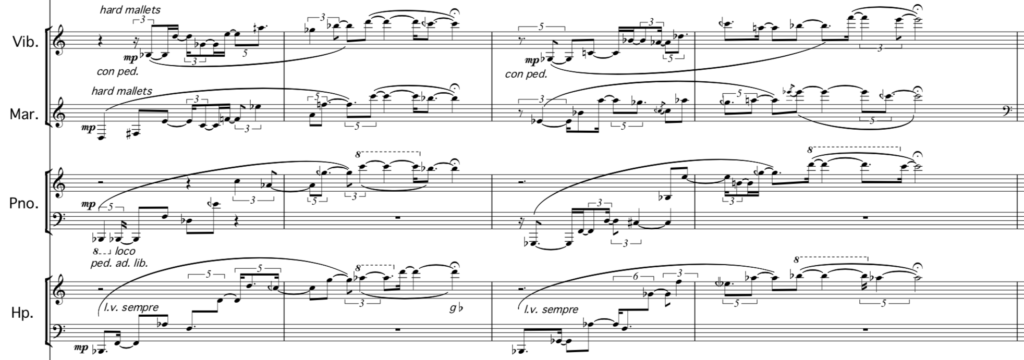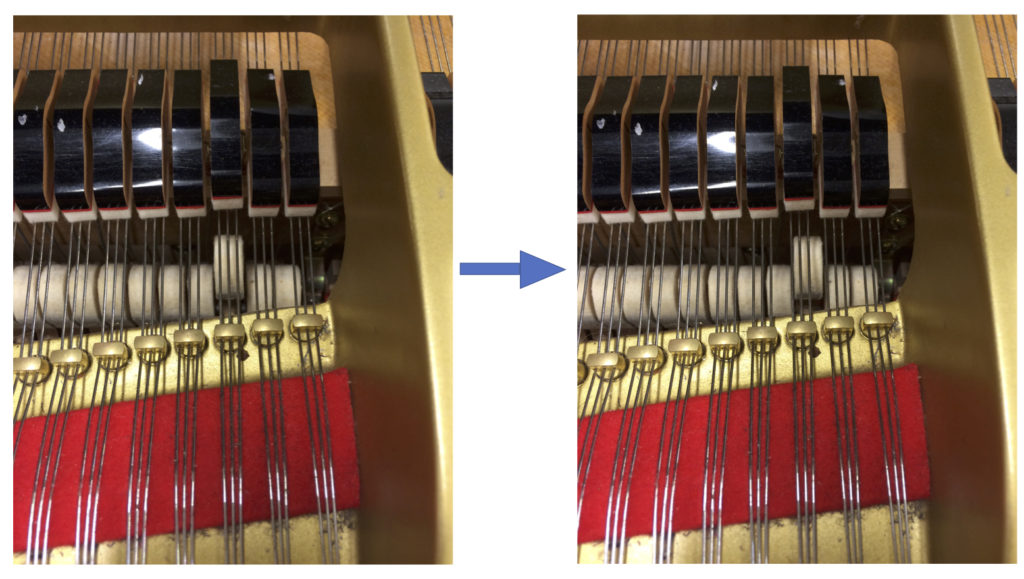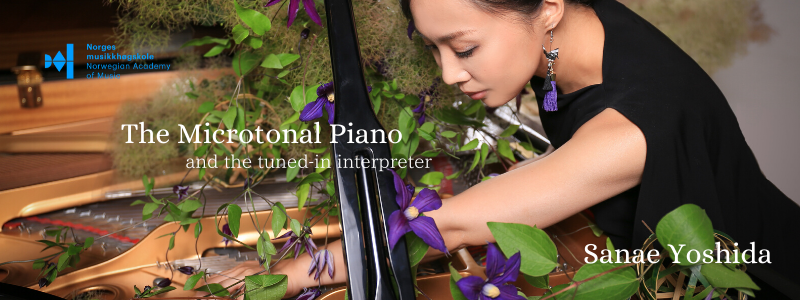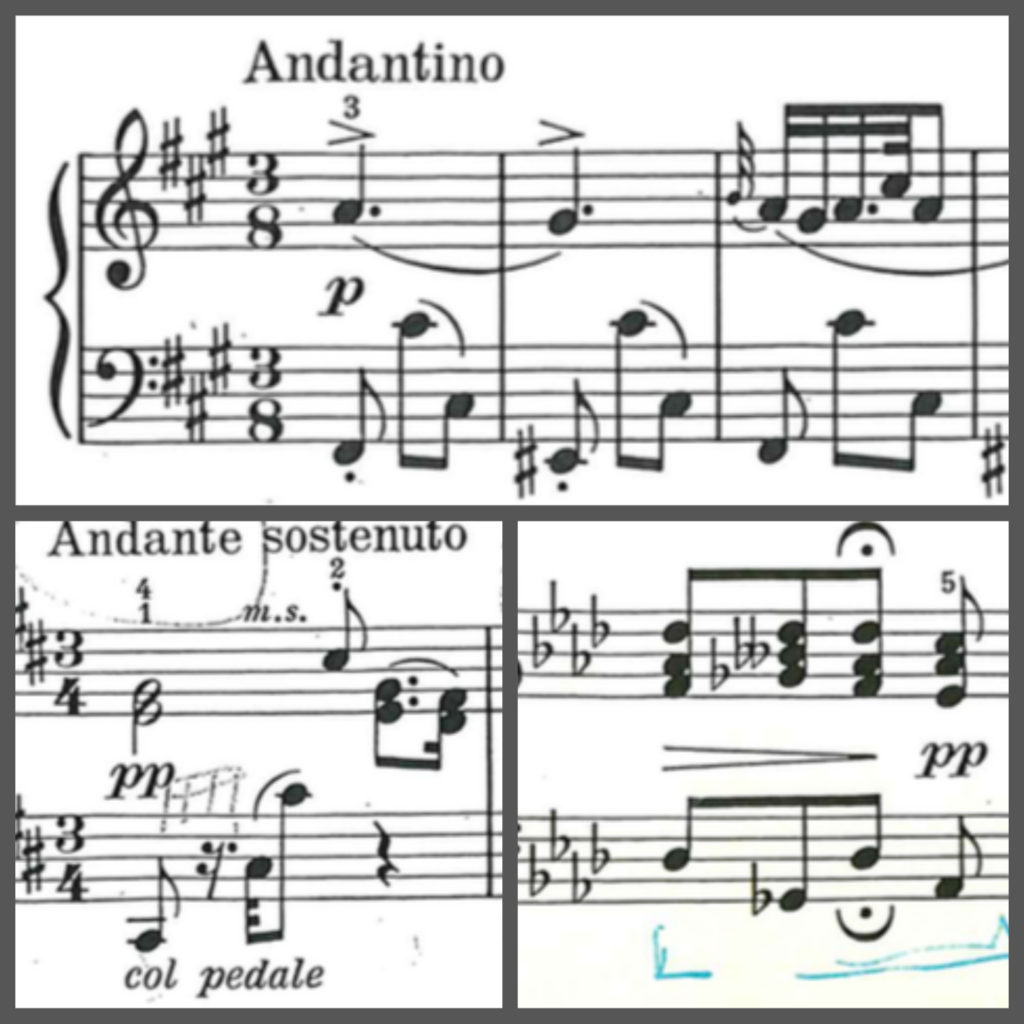Three Studies for microtonal piano (2019)
- Premier:
- At the «Schubert meets Helen Keller» concert
- 30th of October 2019
- Levinsalen, Norwegian Academy of Music, Oslo
Motivation
Several years ago, when I was working at a music high school in Oslo, Eivind Buene once visited the school to give a lecture to the students where he talked about his compositional motivation, how he composes and so on. Then I got to know his works Blue Mountain (2014) and Schubert Lounge, where both works are inspired by existing works; respectively by Gustav Mahler and by Franz Schubert. I later got to know about his research project, ‘Again and Again and Again: music as site, situation and repetition'(2015) , and also that the Oslo Philharmonic Orchestra were planning to perform Buene’s work Standing Stones (2010) which contains musical materials and samples (from the last 80 years) from various recordings of Brahms’ Piano Concerto no. 2. The piano of the orchestra pianist is required to have two of its pitches lowered by a quartertone, and as I was fascinated by Buenes music, and also just had started my research fellowship on microtonal piano, I asked if I could play that part.
So on May 3rd in 2018 I performed the part in the Oslo Philharmonic Orchestra (and also tuned/tuned back the two pitches) at the concert in Oslo Concert Hall, conducted by Eivind Aadland, where Standing Stones was programmed together with Brahms’ Piano Concerto no. 2 and also another work by Buene.
The role of the microtones is to be twisting the material, and the two de-tuned pitches in the piano certainly makes a great effect in this work: It felt like the whole concert hall was trapped in a fourth dimension, with its sense of timelessness, especially around the bar 29-32 where vibraphone, marimba, harp and piano play slightly different rhythms and slightly different pitches (microtonal differences). This phenomenon was probably strengthened through the combination with various recordings of corresponding passages from the 2nd movement of Brahms’ Piano Concerto sounding from speakers spread around the hall.
Performed by
The Orchestra of The Norwegian Academy of Music
(18.11.2010)

Under, follows a quote from Buenes article Telescopic listening about similar multi-layered experiences:
Ever since Felix Mendelssohn reinvented J.S. Bach in 1829, Western musical culture has been obsessed with its past. In recent decades this backward gaze has also installed itself in popular music, making the music that once was the symbol of the youthful now into a feast of nostalgia.1Simon Reynolds, Retromania: Pop Culture’s Addiction to its Own Past (London: Faber & Faber, 2011) But history is not a one-way street. A musical score, even from the darkest corners of history, always inscribes itself on the present through the act of interpretation. Music is always now in the sounding moment. Music is, in a sense, a history of unfinished work. It is a temporal art not only in the sense of how it unfolds in time, but also in how it gives us access to different points in history, layers of time, in the now of the sensuous experience of listening. This mode of listening, where different temporal planes coexist within the same mental image can be called a telescopic mode of listening.
Eivind Buene, ‘Telescopic Listening‘, VIS – Nordic Journal for Artistic Research, 3 (2020) https://www.researchcatalogue.net/view/639287/639288/0/0 [accessed 17/12/2020]
Method
In 2018, I asked Buene to write a new work for the microtonal piano, focusing on ‘twisting’ one or more classical solo piano works’. In 2019, I premiered the work Three Studies for Microtonal Piano, which has several references to Schuberts last piano sonatas. It was Buenes idea to use the same 4 de-tuned pitches as in Griseys Vortex Temporum, in addition to two keys with non-unison string course scordatura (the strings within one string course are differently tuned).
We had several workshops trying out both pedaling and various degrees of microtonal pitch deviation within a string course. In the bass range, the number of strings for a certain key varies on different piano models, so the lowest key with a non-unison string course scordatura, C#3, will have either 2 or 3 strings. We decided to specify an alternative for both these cases in the performance notes. The role of the two non-unison keys was, according to Buene, to sound like an old, out-of-tune piano, rather than creating a delicate timbre. Therefore, we ended up having relatively large pitch deviations (quartertone and 1/6-tone).

Another issue was the use of the una corda pedal (left pedal). When depressed, the una corda pedal makes the hammers hit one string less (within every string course) than when it is released, and in combination with non-unison string course scordatura, which Buene uses, this creates the possibility of going from a clean sound (1-2 strings sounding) to a “dirty” sound (2-3 strings sounding). However, because of a misunderstanding, Buene thought that “una corda” means that only one string is in use, so some adjustments to the pitch deviation had to made after the premier, to get it right.
Visualization
Ever since the world premier of Three Studies for Microtonal Piano, I had imagined that some kind of visualization of this solo work could become very interesting.
As the Covid-19 situation resulted in a lot of cancellations and postponements, I decided to set aside some time to actually make it happen.
In August 2020, I recorded the work on the label of Lawo, and together with filmmaker and animator Audun Nedrelid, we started working on what would become a mix of a short movie and a contemporary music video.
In my opinion, Three Studies for Microtonal Piano is a strong work, that, in spite of its very neutral title, sparks the imagination, not just because of certain referances to Schubert’s last piano sonatas, but also through how the composer treats and includes the microtones, which in fact are quite few.
We believed that an animated short film would be a good format for visualizing the associations, partly because it would give us an artistic freedom that would be much easier to realize with a low budget. We hope that the beauty vs brutality of the work, will create an exciting emotional journey also for an audience unaccustomed to contemporary music.
Nedrelid is inspired by the expressivity of Munch, where the artist not just scrapes the paint off, but scrapes into the canvas itself.
We are curious to see if an animated music video could be a way to present contemporary music to a broader audience. It will be published at several sites online (including youtube), and we also believe that it could be presented at f.ex short film festivals. The film will be released/published early Spring 2021.
Method regarding the music video version
It all started simply with my own chronological list of associations – with events/atmospheres in the work that I imagine could be treated visually, in a mimetic/commenting or contrasting relation to the music.
Nedrelid created a storyboard based on the rather spontaneous associations I go through when performing the work.
When making the new recording in August, I noticed that I was, due to all the work with the detailed “list of associations” and the collaboration with Nedrelid, much more personally attached to the work, and probably therefore also had a much clearer impression of the timbres and phrases I wanted to perform. I believe I then could express the music more freely and convincingly than when I had premiered the work.
After a while, I noticed that several of my associations probably had been colored by my increasing awareness the last year of the general conflict of majority vs minority – the microtone being one of many metaphors for minority. These ideas now became the driving force of the “plot” in our little film.
When we continued working in the autumn, we realized that my free imagination didn’t really take dramaturgy into account, and even though we always imagined some surrealism, we had reached a dead end: There were too many elements that couldn’t be united, and that became more confusing and disturbing, so we ended up inviting the theatre director Eliot Moleba, to guide us back on track. This proved to be very helpful, and he managed to structure the minority concept in a much more coherent way.
The original list of associations is however still influencing the ending result, as it creates and colors events on a more detailed level, and it will later be interesting to compare these first spontaneous ideas to the finished work.
Read more about my concept of minority in the 3rd section of the “Other thoughts” (see below).
Other thoughts
1.
In November 2019, I had a so-called LAB lecture for master students at NMH. They were all classically trained musicians, and none of them were pianists. Me and pianist Ellen Ugelvik played extracts from several composers’ pieces and some recordings from the concerts including Buene’s Three Studies for Microtonal Piano, and some of the string players reacted interestingly: They couldn’t stand listening to the de-tuned piano of Buene without thinking about making mistakes – as if unwillingly playing out of tune.
We then performed the work by Jonas Skaarud that uses 8 e-bows laying on the strings of the 2 pianos, and nothing else (no keys in use). Now, none of the 13 master students reacted to the fact that the piano was microtonal, even though there were 15 quarter tones in use in my piano part! The ebow makes a sound that reminds of electronic sine tone, but could this alone be the reason why they suddenly accepted the microtones?
2.
A comment on the choice of microtonal pitches in Buenes work: Gerard Grisey spent years finding the ideal tuning for his work Vortex Temporum. Probably because I suggested the composers in the project to look for practical solutions concerning tuning, in fact several of the composers – not only Buene, chose to use the Vortex tuning. Still, I’m questioning the choice of microtonal pitches in these works: Did they skip some of the inventive listening process that Grisey so thoroughly went through, simply for the benefit of more practical concert programming?
3.
Though my starting point of the project was very technical/practical, last year my focus however shifted slightly, now focusing more on the concept of minority and some of its implications. “Musical minority”: I myself am a non-western classically trained pianist playing western contemporary music on the microtonal piano). This, of course leads to minefields of ethics, and though I will not be able to go in depth into this matter in my research project, I still want to share these thoughts since I find it interesting to view my motivation and project from this angle as well.
The standardized way of sharing research is limiting. It is necessary to have a common language, and the research should be shared, and also refer to others and other research.
And so, a simple but difficult question arises in my mind, as our research model is a result of Western culture, and researchers almost only refer to Western literature, at least within the field of artistic research: What happens to the “minorities” – f.ex the research being written in Japan in Japanese (or other languages), without the funding to let it be translated, etc.?
One might find a parallel hierarchy in music, where Western music culture and especially it’s tuning system (12tone equal temperament – 12TET) has colonized almost the entire planet. Almost all music (old folk songs, instruments etc) has been adjusted to the 12TET. Only some few individuals or obscure groups of “nerds” and ideologists will continue to maintain or further develop the their “minority tunings”. Of course, no one thinks this makes the non-western music less valuable. But whenever the minorities are to be researched, they must necessarily be compared with a standard, again the Western standard, in order to articulate how extraordinary they are.
I am a Japanese artistic research fellow within a Western system that I deeply admire, and try to learn from. At the same time, I would very much like to raise some awareness both to myself and others about this issue – both about the non-Western and the non-standardized – the minority – through my project.
When discussing the minority concept with director Moleba, he asked me to make a list of the “obstacles for microtonality”, as this could offer him some parameters to work on when structuring the plot. Though the list I sent him, might seem simple and banal, I choose to show it as this turned out to be an important step forward for our project:
- Most people are not used to it, and even don’t get a chance to experience it and know about it. (Today, almost everywhere)
- The minority is laughed at (regarded as “dirty”, “out of tune!”), even before it’s really listened to. (Today, almost everywhere)
- It is not included in mass production. (Mass production of pianos (and also most other instruments) in Europe, the States, ever since the 19th century…and later also in Japan, Korea, China.)
- “Standardization is safe” (Not time/space specific, I suppose, but this interestingly very much describing the time we’re living in, too. Standardization is, I suppose, also a result of the Industrial revolution)
- The majority ignoring sensitivity/nuances. (Not time/space specific, I suppose)
- Colonialism – powerful countries rule. In music, ancient and non-western scales have been squeezed out, forgotten, or made insignificant. (Europeans in the 19th century brought their tuning system to cultures in f.ex East-Asia. Music conservatories (for western classical music) appeared in many cities. Of course, this is not a bad thing in itself, but it started to dominate almost all music genres. But this in fact also happened to European folk music, not least in f.ex. Norway.


